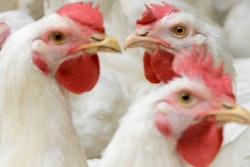
Animal welfare is becoming an issue of greater public concern. The poultry industry, as well as the rest of animal agriculture, needs to consider how this can affect their business going forward.
Dr. Candace Croney, director of the Center for Animal Welfare Science and professor of animal behavior and well-being at Purdue University, spoke about the growing ethical concerns of consumers and what that means for the industry. Croney, one of the authors of the Council for Agricultural Science and Technology’s (CAST) 2018 report, “Scientific, Ethical, and Economic Aspects of Farm Animal Welfare,” spoke about this topic as part of the North American Meat Institute’s Animal Care and Handling Conference in Kansas City, Missouri, on October 18, 2018.

Dr. Candace Croney, Perdue University | Thomas Campbell, Purdue University, Agricultural Communications, College of Agriculture
The role of the consumer and public perceptions
Croney, who specializes in the ethics of animal welfare, said the industry is struggling in how its attitude toward animal welfare is perceived by consumers. Moreover, it is facing the tough question of what role consumers’ attitudes toward animal welfare and social responsibility should play in how animals are raised.
Historically, the industry focused on how consumer desires don’t always match up with consumer behaviors. That disconnect is shrinking, Croney said. Shoppers are still motivated by price, quality and food safety, but for some, their values are playing a bigger role in their decisions.
That’s because animal welfare and food are no longer just science issues. They are now intertwined with values and many people see animal welfare as a social justice issue they want to see comprehensively addressed.
Beyond questions of personal preference, these consumer attitudes are already manifesting in policies restricting the way farmers raise their animals. In the past three years, voters in both California and Massachusetts approved laws requiring all eggs sold in the states come from cage-free hens by 2022. This, according to the conclusions of the 2018 CAST report, demonstrates how consumers can create unfunded producer mandates banning or barring the use of industry standard housing.

Changing preferences and attitudes toward animal welfare are motivating changes in husbandry, like adding windows for natural light in broiler houses. | :kornnphoto | iStockPhoto.com
Competition between high-tech and tradition
The cage-free laws speak to how the march of technological progress may come into conflict with the growing desire to turn back the clock on farming methods. Croney asked how a richer, more populous world will be able to feed itself if farmers are forced to return to less-efficient production methods due to welfare concerns.
More automation is coming to the farm. Croney highlighted how Cargill Inc. is already using robots to herd cattle. Similar robot technology is developing in the poultry industry for both broilers and layers. In China, hog farmers are developing high-rise style housing to produce more animals on less land. These mechanical and housing advances are designed to save labor and create efficiency, but some consumers may ultimately view these advances negatively.
Croney asked, “When we invest in these types of technologies are we further perpetuating the idea that we’re increasingly disconnected from animals, that we’re increasingly industrialized?”
In an interview, Croney said the industry must be cognizant of this conflict and consider it before implementing these advances. If consumers decide to reject goods produced using these novel technologies for whatever reason, then the investment in developing these technologies may be wasted.
Greater understanding is needed
There is no silver bullet solution for all of these problems. Consumer values and perceptions are not homogenous and can vary among species and even products coming from the same species. However, the industry as a whole must focus – and be willing to invest – more on researching consumer perceptions and attitudes toward animal welfare.
Croney said there’s a deficit of understanding of the extent to which consumers know about animal welfare, how interested they are in the specific topics and if they are agitating for change. Genuine sentiment must be separated from the noise coming from animal activists.
Consumers care about price, taste, quality and food safety, but real conversations and focus group research around what consumers think and really care about in terms of animal welfare are needed. Animal agriculture could make better decisions on welfare policies, and potentially make smarter investments, armed with that knowledge.
Consequences of ignorance
If the industry doesn’t put in the work to connect with consumers on this topic, it may end up getting feedback exclusively from activist or special interest groups, Croney said. These entities don’t speak for the whole buying population and don’t necessarily represent them accurately.
Furthermore, the industry must be willing to review and reform its own animal welfare policies and practices without first being pressured to do so by activist groups. If the industry doesn’t have the framework or onus for introspection on welfare, then it will always be playing catch up in terms of both public trust and credibility.
Croney said when communicating with consumers about animal welfare practices, the industry should consider what’s its doing right and what success looks like now and what it will look like in the future. She fears the industry does not have a goal for what success looks like.
“If that’s the case, then we don’t know necessarily where we need to go in terms of advancing, in terms of getting the message out on animal welfare to the different publics that are out there – that are not a monolith – who are hungry for information and are not necessarily getting it from scientists, farmers or industry,” Croney said.


















